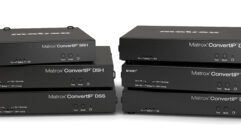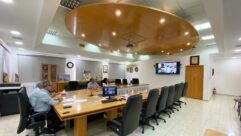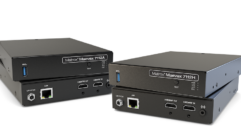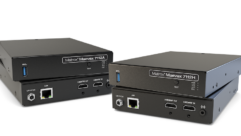STREAMING video
Jun 1, 2000 12:00 PM,
Peter H. Putman
This year’s NAB trade show in Las Vegas was filled to the rafters withexhibitors and attendees, but the buzz was all about the mixing of InternetProtocols (IP), high-speed networks and video – a potent combination oftechnology that goes by the name of streaming video. The idea of movingvast amounts of data (still and moving images plus audio and controlsignals) over everyday telephone lines has been the obsession of manycomputer software and hardware companies for the past few years. Theexplosive growth in use of the Internet and websites has only stirred upthe frenzy.
As a result, dotcom companies promising delivery of MPEG-2 video on demand(VOD) from central servers were everywhere in the Sands Expo Center (with afew parked in the Las Vegas Hall) demonstrating file servers, networkmanagement software, videoconferencing and a mix of digital video anddatacasting. It all seemed like a carnival sideshow, particularly given thestock market’s recent bloodletting of technology and Internet stocks.
Even though my area of interest is electronic displays, I visited severalbooths to hear the breathless accounts of proprietary technology, losslesscompression and high-speed downloads offered up by one visionary afteranother. It was hard to stay awake through all of the technical details(imagine getting this bombardment every 30 minutes, 10 to 12 times a day),but I did see a definite trend emerging, one which will have a directimpact on your business.
That trend is an industry-wide switch-over from analog to digital signaltransport, and its implications are many. For starters, the day will sooncome where we will not need to worry about a particular video signal formatand its compatibility with display devices. Gone will be the days ofthree-, four- or five-wire video cables. Goodbye to choosing between syncon green, composite sync or component sync. Instead, we will have astandardized cable interface, and all of the signal processing will be doneby smart microchips at either end of the chain. All that you will need todo is plug in the cable, and the display will figure out the rest. Theremay be a few menu adjustments here and there, but the connection itselfwill probably be a single cable.
Additionally, that single cable will not be limited to carrying video. Itwill also be the transport stream for audio signals and all of those bitsand bytes that make up a control system. Again, the smart electronics willbe able to decipher individual bytes and determine whether a picture needsto be shown, a PowerPoint slide needs to be changed, audio needs to beplayed back and the room lighting needs to be adjusted. Think of a six-laneinterstate highway carrying everything from motorcycles to SUVs and eventractor-trailers, and you will start to get the picture.
We are already seeing the beginning of this changeover, courtesy of CAT5cable. Several manufacturers are now showing connectivity solutions that use analog-to-CAT5 converters at the sending and receiving end. Proxima showed its concept of a connected conference room in the Sands Expo Center usingCAT5 cable and converters to mix video, audio and control signals. InFocushas already shown a variation on this concept, and you can be sure thatother manufacturers are working hard on it.
Why CAT5? It is cheap, much cheaper than coax. Plus, it already comesbundled, meaning you have to pull just one run, and it can serve aseverything from a video interconnect to part of a LAN hub. All that youwill need is the appropriate analog signal converter. Yes, there will be alot of those making their debuts at INFOCOMM in June.
Although this conversion to CAT5 bundling of video, audio and controlsignals is an important step, it is but an intermediate step. In thebroadcast world, all of the data required to display digital video signals(whether ITU-601, SMPTE-274 or SMPTE-296) travel on a single coaxial cableor fiber optic bundle. This can include data to control display formats andprovide supplementary data, such as closed captioning and even datacastingon HDTV channels.
I have been doing some extensive testing of HDTV receivers and antennas inmy home studio for the past few months, and I recently took delivery of aPanasonic PV-HD1000 VCR. In addition to regular VHS Hi-Fi recordings, thisconsumer VCR also records a format known as D-VHS. With D-VHS and anappropriate Panasonic DTV decoder (such as its TU-DST50 or TU-DST51), I canmake perfect copies of any HDTV broadcast for later playback. In effect,the D-VHS VCR works as a streaming video storage device, recording the full19.4 Mb/s data from the local TV station as MPEG-2 video. The set-top boxperforms the reception and translation from the ATSC 8VSB signal format.All that is required between the two boxes is a small two-prong Firewire(IEEE 1394) cable.
With this cable, I also have full control of the VCR’s functions from theset-top box. I can program either of two seven-day timers to startunattended recording. I can play, fast-forward, rewind and pause the tape(for about 30 seconds). The audio for each program is also streaming offthe tape to the receiver as either a Dolby 2-channel stereo mix or Dolby5.1 surround through that same cable.
There is no reason that Panasonic could not have programmed a few morefunctions into the set-top box, such as a lower/raise screen command, lightdimming and full control of a home theater audio system. Again, all ofthese would travel as serial bits of data down that same Firewire cable. Nocoax, no phone wire, no audio cables and no nine-pin RS-232 jumpers wouldbe needed.
As a systems integrator, should you be concerned? Possibly. SeveralJapanese electronics firms who service both consumer and professionalmarkets are researching and developing similar types of protocols forfuture home automation products. You can already see a marked consumerinfluence on the styling of professional displays, such as projectors(ultraportables and desktop models) and monitors (plasma and LCD).
What this means is that while the need for systems integration of theseproducts will increase, the level of knowledge required to do thatintegration will decrease. Yes, wires will still have to be pulled andconnected, but the number of wires will decrease (a plus for the customer).In some cases, customers may be able to perform some of the work themselvesif the installation is simple.
This drift towards plug-and-play will bring more players into the systemsintegration game, and many of them will come from LAN disciplines. They maynot know much about analog video and audio, but they will understandall-digital interfaces and be able to implement them. These folks arealready used to pulling and connecting RJ-style multiwire interfaces, andsome are even familiar with Fibre Channel and fiber optics – two premiumdigital transports.
Manufacturers of remote-control systems and interfaces will also have to bequick on their feet because they will no longer be the only game in town.Instead of serving as the go-between with manufacturers of projectors,monitors, audio reinforcement and lighting control systems, they will be incompetition with many of those same manufacturers.
This shift from complex analog signal distribution systems to one-wiredigital systems is just another inevitable trend that began with theintroduction of the original Firewire digital video (DV) camcorders in1995. Professional video-graphers realized that these cameras would providehigh-quality video and audio at a fraction of the price of earlierprofessional rigs.
The digital avalanche has already washed over the film, video and audiopost-production industries. Instead of open-reel tape decks and complicatedediting systems, a computer workstation with the appropriate I/O boxes isused to sample, record, edit, compress, expand, store and retrieve videoand audio data. Now, many production companies use high-speed digitalnetworks to access and move huge streams of data around buildings andsometimes between them.
The limiting factor to all of this digital signal shipping and receiving isbandwidth, of course. Ordinary coax may be sufficient for moving serialdigital video (D1 or D2) plus Dolby audio and control streams, buthigh-definition video and digital high-resolution computer displays mayrequire the use of fiber optic cables. It will still be a single cable,only fatter.
It may be that DTV services are implemented faster over IP networks (suchas off the Internet) than on cable, satellite or off-air. Soundsimpossible? Not if you have enough bandwidth. It is true that HDTVtransmitted with the ATSC-standard 19.4 Mb/s compression would require veryhigh-speed DSL, but what if it were to be compressed even further? For thatmatter, what if SDTV at lower resolution were transported using one-sixththat rate or a little over 3 Mb/s? Although DSL and even T-1 connectionsare not fast enough to pull that off, 100baseT Ethernet and Fiber Channelcan do it without breathing too hard. Do you know about either of thesenetwork standards? You should, particularly if you are looking at systemsintegration jobs involving any kind of a local area network.
If you have not gotten up to speed yet on the ins and outs of digitalsignal processing, now would be a good time to start. There are numeroustechnical references available that cover the specifics of video and audioencoding. See the following sidebar for four texts that are particularlyhelpful in understanding many of the concepts. Although they can be a dryread at times, you should find them handy as a shelf reference.










